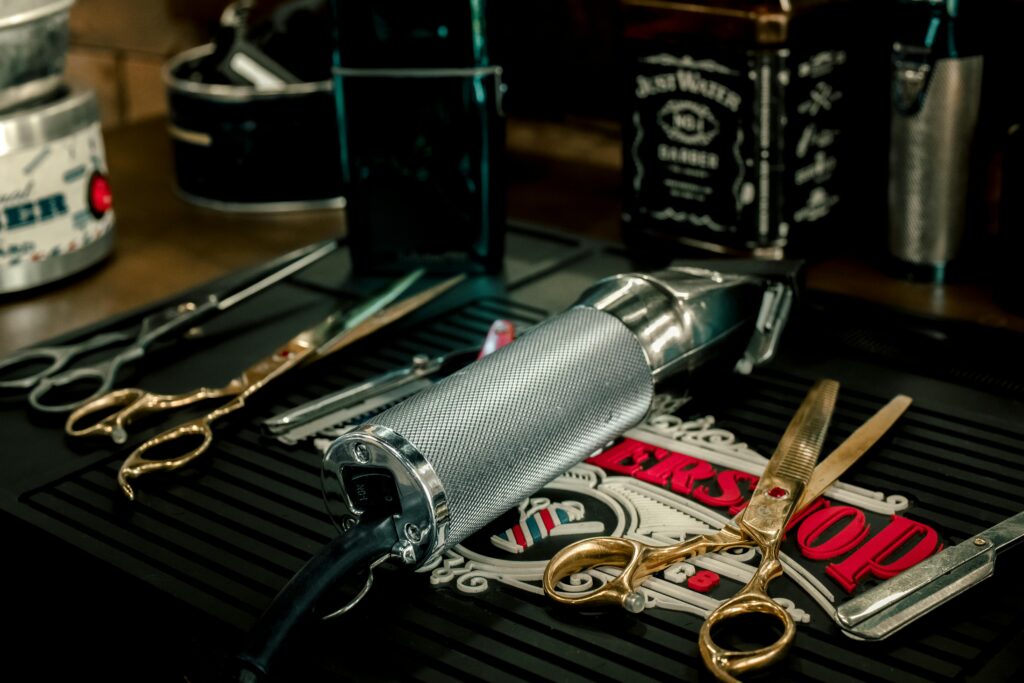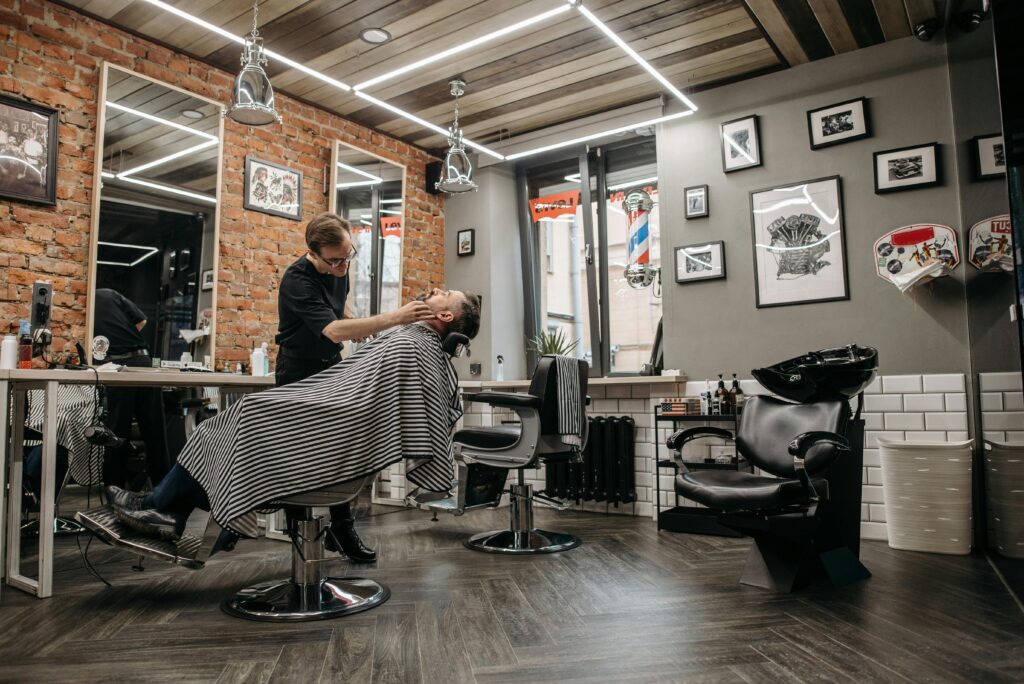Barbering Skills You Need to Develop for Success
Barbering is very technical but in the world of barbering, the difference between a good barber and a great one isn’t just technical mastery, it’s the unseen layers of human psychology, subtle persuasion, and behavioral nuance that turn a haircut into an experience worth returning for.
1. Why “Good Enough” Isn’t Enough
Clippers and scissors are just tools, what matters is the perception of craftsmanship. A seamless fade isn’t just a haircut; it’s a confidence boost, a status signal, a silent proclamation that says, “I pay attention to details.” But here’s the secret: the real skill isn’t just in the cut, it’s in making the client feel like they got something bespoke.
Technical Skills:
- Mastery of fades, tapers, and scissor-over-comb techniques
- Understanding hair textures (straight, curly, coarse) and how they behave
- Razor-sharp detailing for crisp lines and symmetry
Soft Skills:
- The ability to listen, not just to what the client says, but what they don’t say
- Reading body language to adjust technique in real-time
- Creating the illusion of effortlessness, (even when the cut is complex). This comes with experience.
2. The Barbershop as a Tribal Gathering Place
Barbering isn’t just about cutting hair, it’s about social signaling. A barbershop is one of the last places where men engage in unscripted conversation. The best barbers don’t just cut hair. They curate an atmosphere where trust is built, advice is exchanged, and loyalty is earned.
Key Psychological Triggers:
- Reciprocity: Offer a free touch-up or product sample, clients will feel obliged to return.
- Authority: Speak with confidence about styles and products, because you know your stuff.
- Social Proof: Display Instagram-worthy transformations. New clients will want their own before and after moment
3. The Hidden Power of Soft Skills
You could be the best technical barber in town, but if you’re gruff, distracted, or fail to build rapport, clients will quietly vanish. The magic lies in:
- Mirroring tone & energy (if a client is chatty, engage; if they’re quiet, respect it)
- The “consultation illusion “asking “What are we thinking today?” instead of “What do you want?” makes them feel co-creative.
- The post-cut ritual, a hot towel, wash, blow, style, a final mirror check. These small touches feel luxurious, even if they cost little.

4. Why Hygiene is a Silent Salesman
A messy station doesn’t just look unprofessional, it feels unsafe. Disinfecting tools visibly (even if you already did it) reassures clients subconsciously.
Sweeping hair immediately after a cut isn’t just cleanliness it shows that you do the basics well. Good hygiene builds trust.
5. Pricing as Perception
A premium haircut isn’t just a haircut, it’s a statement. Price too low, and clients assume lower quality. Price too high without justification, and they’ll revolt.
The sweet spot? Anchor pricing (show a premium service first, making mid-tier options seem reasonable). The client never wants to feel cheated, offer great service but ensure you charge enough to make your business make sense.
Ready for a Cut That Feels Like a Masterclass?
Find a barber who understands that every snip is backed by science, every conversation is crafted, and no detail is left to chance. Because a haircut isn’t just a haircut it’s a strategic advantage.
Barbering Skills FAQ: Mastering the Craft & Business
1. What are the most important technical skills for a barber?
- Cutting techniques: Fades, tapers, scissor cuts, clipper work, texturizing
- Tool mastery: Clippers, shears, razors, combs, and trimmers
- Hair knowledge: Understanding textures (straight, curly, coarse) and growth patterns
- Detailing: Clean necklines, sharp edges, and symmetrical shaping
2. What soft skills make a great barber?
- Communication: Active listening, asking the right questions, explaining styles
- Customer service: Building rapport, managing expectations, handling complaints
- Adaptability: Adjusting to different personalities and hair types
- Time management: Keeping appointments on track without rushing
3. How can I improve my barbering skills?
- Practice daily: Work on mannequins, friends, or family to refine techniques
- Take advanced courses: Learn new styles (e.g., skin fades, beard sculpting)
- Watch tutorials & attend workshops: Stay updated on trends and techniques
- Get feedback: Ask loyal clients and mentors for constructive criticism
4. What’s the best way to handle difficult clients?
- Stay calm & professional: Don’t take complaints personally
- Listen first: Understand their concerns before responding
- Offer solutions: Adjust the cut, recommend styling tips, or provide a discount if needed
- Set boundaries: Politely decline unreasonable requests
5. How important is sanitation in barbering?
- Critical! Poor hygiene can spread infections and damage your reputation.
- Best practices:
- Disinfect tools (clippers, scissors, combs) after each use
- Use disposable blades and neck strips
- Keep workstations clean (sweep hair, wipe surfaces)
- Wash hands regularly
6. How do I stay updated with the latest barbering trends?
- Follow industry leaders on Instagram, YouTube, and TikTok
- Attend barber conventions & trade shows
- Subscribe to barbering magazines & blogs
- Experiment with new styles on willing clients
7. What’s the best way to build a loyal client base?
- Consistency: Deliver great cuts every time
- Customer experience: Offer a friendly vibe, remember preferences
- Social proof: Encourage reviews, post before/after photos
- Retention tactics: Loyalty programs, follow-up messages
8. Should I specialize in a specific style (e.g., fades, classic cuts)?
- Early on in your career be versatile, master basics first.
- Then as you gain experience specializing can make you the “go-to” for certain looks.
- Check what’s popular in your area.
9. How do I price my services competitively?
-Research local barbershop rates, factor in experience, location, and overhead costs.
-Offer tiered pricing (e.g., basic cut vs. premium cut with beard trim)
-Adjust as you gain reputation
10. What’s the biggest mistake new barbers make?
- Rushing cuts: Leads to mistakes and unhappy clients.
- Ignoring soft skills: Technical skill alone won’t keep clients coming back.
- Skipping sanitation: Risks health violations and lost trust.
Checkout our guide on the tools that you need to succeed.
Latest Articles:
- The Perfect Chelsea NYC Day | A Sharp Cut & the Ultimate Neighborhood Day | Best Barber Near
- A Perfect Midtown East NYC Day | A Premium Cut & Conquering Midtown East | Best Barber Near
- Your NYC Upper West Side Day | Fresh Fade, Food and Exploration | Best Barber Near
- The Perfect Park Slope Day in Brooklyn, New York City | A Fresh Cut and Local Exploration | Best Barber Near
- The Perfect Day in Rose Hill, NYC | A Fresh Fade, Madison Square Park, Flatiron Building | Best Barber Near

Leave a Reply